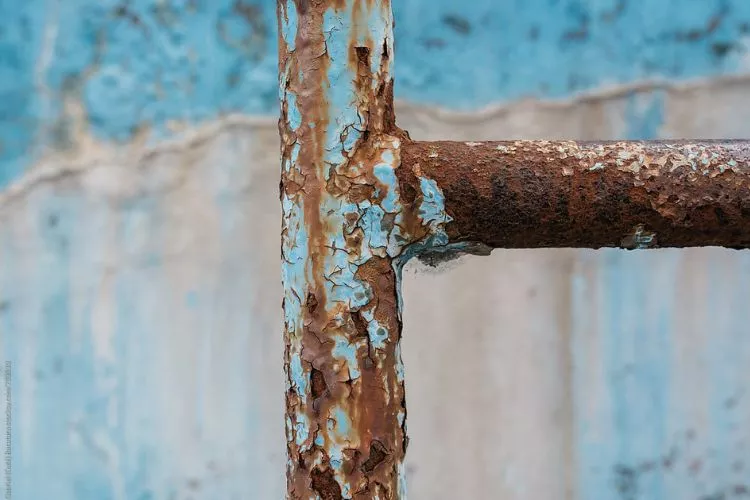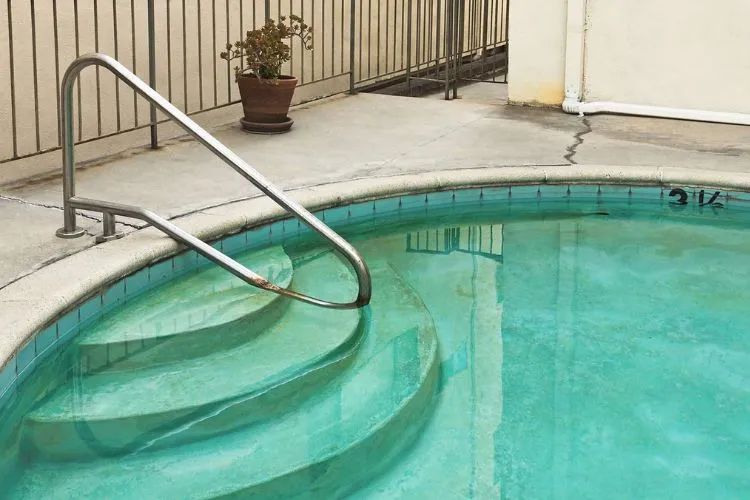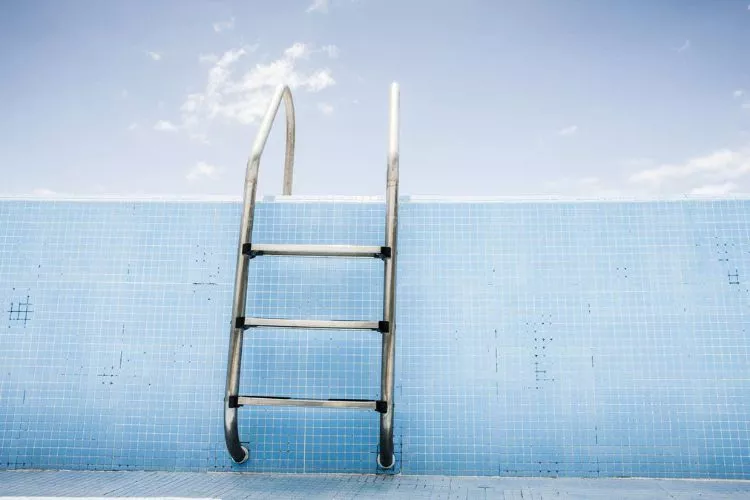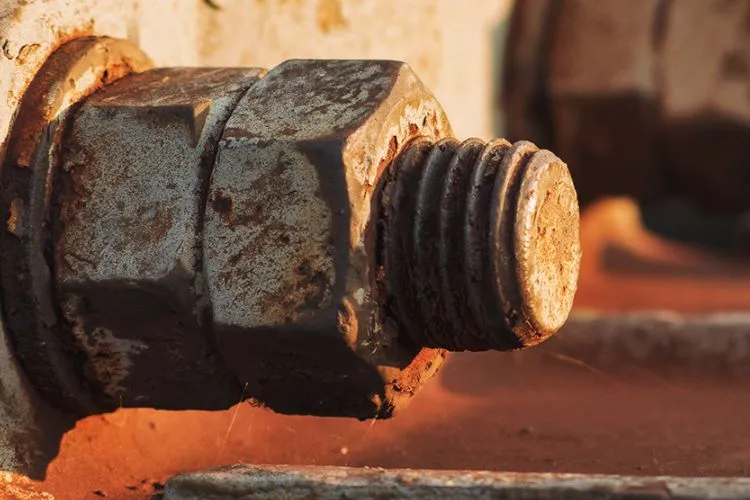Pool ladders are essential for safety and convenience, but can a pool ladder rust?
This comprehensive guide will provide you with essential insights and general information, focused on the materials used in manufacturing pool ladders, their susceptibility to rust, and the impacts of this phenomenon on your pool ladder’s longevity and safety.
As a pool owner, understanding the factors that contribute to rust formation and implementing preventive measures can significantly enhance your pool experience, ensuring a well-maintained and safe swimming environment for you and your loved ones.

Stay with us as we dive deep into this important topic.
Can A Pool Ladder Rust? An Honest Answer
Yes, a pool ladder can indeed rust. While many pool ladders are made of stainless steel or plastic, which are resistant to rust, they are not fully immune to it.
time, due to continuous exposure to water, climate elements, and the powerful chemicals present in the pool’s water, even the sturdiest stainless-steel pool ladders can develop rust. The stainless-steel ladder loses its anti-rust properties when its outer layer is worn out, promoting corrosion.
This does not only make the ladder unsightly but also poses a potential health risk, as rust may cause injuries or affect the water quality. Additionally, rust could weaken the ladder over time, affecting its overall durability and safety.
Therefore, regular inspection, maintenance, and implementation of preventative measures are essential for pool owners.
How do you get rust off pool stairs?
Rust on your pool stairs not only detracts from the overall aesthetics but could also cause potential safety hazards. Follow the steps outlined in this guide to remove the rust effectively.

- Identification and Safety Precautions: Identify all the areas where rust has developed. Once spotted, ensure you wear rubber gloves and safety glasses for protecting from rust particles and chemicals used in the process.
- Using a Rust Stain Remover: Buy a rust stain remover suitable for pools. Apply the remover to the affected areas according to the instructions provided by the product manufacturer. Most removers will need to sit for a short period to break up the rust.
- Scrubbing: Use a scrub brush (preferably with stiff nylon bristles) to scrub the affected areas gently so you don’t damage the stair’s surface. For stubborn or large rust spots, you may need a pumice stone. Remember not to scrub too hard to avoid scratching the stairs.
- Rinsing: After scrubbing, rinse off the rust and the rust stain remover agent thoroughly to prevent chemical imbalances in the pool water.
- Repeating the Process: If rust remains, repeat steps 2-4 as necessary until the stairs are clean and rust-free.
- Treating the Pool: Once the stairs are cleaned, run a chemical balance test on your pool water and adjust the pH, alkalinity and sanitizer levels as necessary, as per the pool’s requirement.
- Prevention: Apply a rust-proof coating, typically composed of epoxy or rubber-based paint, after completely cleaning and drying the stairs. This additional step will help prevent future rust development.
- Routine Inspection and Cleaning: Routinely inspecting and cleaning your pool stairs can ultimately prevent rust and prolong the stairs’ life.
Remember, always work in a well-ventilated area and follow safety measures while working with chemicals. If the stairs are overly rusted, it’s more beneficial to replace them for safety reasons.
How do I stop my pool ladder from rusting?
Keeping your pool ladder rust-free requires both preventative measures and regular maintenance. Here is a detailed guide on how you can prevent your pool ladder from rusting.

- Choose Rust-Resistant Ladders: Preventing rust starts with purchasing a pool ladder made of rust-resistant materials. Stainless steel and plastic ladders are the community’s top choices. Ensure that your chosen ladder is specially designed for the pool environment, featuring enhanced anti-corrosive properties.
- Proper Installation: Ensure the ladder is installed properly. Faulty installation may damage the ladder’s protective layer, making it more susceptible to rust.
- Regular Cleaning and Inspection: Regularly clean your pool ladder with a non-abrasive cloth and mild cleaning solutions. Harsh chemicals may strip off the protective coating. Inspecting it frequently will draw your attention to any signs of rust or damage early.
- Use Anti-Rust Coatings: Consider applying an anti-rust spray or coating on your ladder. These products form a protective layer that prevents the metal from oxidizing.
- Balancing Pool Chemicals: Unbalanced pool chemicals often expedite rusting on ladders. Regularly check and adjust your pool chemistry to safe levels. pH levels should be between 7.2 and 7.6, while the alkalinity should be between 80 and 120 parts per million.
- Winterize Your Pool Ladder: If you live in a cold climate, remove the pool ladder during winter. Cold weather could cause damage to the ladder and speed up rusting.
- Repair and Replace: If your ladder is showing signs of rust, take action right away. Sand down the rusty areas, apply a rust neutralizer, and then a primer and paint. If the ladder is severely rusted, replace it immediately to ensure safety.
By following these steps, you should be able to keep your pool ladder rust-free, ensuring that it stays safe and aesthetically appealing to use.
How do you waterproof rusted metal?
Weather conditions and water exposure can cause metal to rust. However, rust can be treated and the object can be effectively waterproofed to prevent future oxidation. Here’s a step-by-step guide to help you in the process:

- Safety Measures: Before starting, ensure you equip yourself with the necessary safety gear, including gloves, goggles, and a mask. This will protect you from rust and dust particles, as well as from the chemicals used in the process.
- Clean the Surface: You’ll want to thoroughly clean the surface of the metal to remove any loose rust or problematic surface residue. A wire brush or sandpaper can be used for scrubbing away the rust. For more stubborn rust, you could use an angle grinder with a brush wheel attachment.
- Apply Rust Converter: Once you’ve removed the rust, apply a rust converter. This product interacts with the rust to chemically convert it into a black, waterproof polymer. Some rust converters also have priming properties. Follow the manufacturer’s instructions for application and drying time.
- Prime the Surface: If your rust converter doesn’t have priming qualities, you should prime the metal surface. Use a rust-inhibiting metal primer. Allow it to dry completely according to the instructions on the product’s label.
- Apply Paint: After the primer has dried, apply a layer of waterproof paint. This takes an extra step of waterproofing by providing an additional barrier between the metal and any moisture that it may get exposed to. A paint that’s designed for use on metal and outdoor items is generally the best choice.
- Protective Top Coat: For added protection, you can apply a clear, waterproof topcoat over the paint. This adds another layer of protection against weather elements, and it can also give the paint job a more professional finish.
- Regular Maintenance: Perform regular maintenance checks to ensure the waterproof finish remains intact, and no new rust forms. A fresh coat of topcoat may be needed from time to time due to wear and tear.
By carefully following these steps, you should be able to effectively waterproof your rusted metal and prevent further corrosion.
Conclusion:
While pool ladders, particularly those made from stainless steel or plastic, are designed to resist rust, they are not wholly immune. The continuous exposure to water, harsh pool chemicals and weather elements can lead to the formation of rust over time.
This rust not only affects the aesthetics but also the durability, and safety of the ladder.
However, through regular cleaning, balance of pool water chemistry, timely attention to rust spots, and proper winterization, the longevity of the ladder can be significantly extended, keeping your swimming experience both safe and enjoyable.


